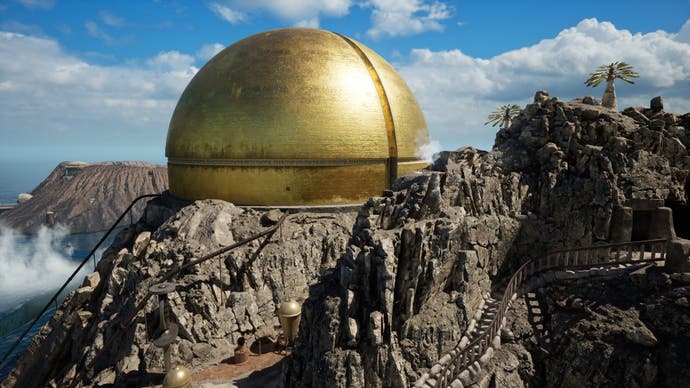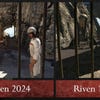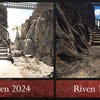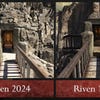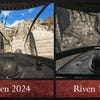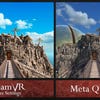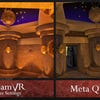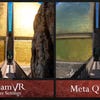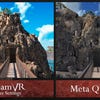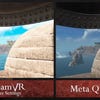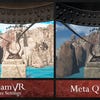From CD-ROM to Unreal Engine 5: Riven returns in spectacular style
Real-time 3D and VR deliver the immersion we could only dream of in the 1990s.
A classic adventure built in the early days of the multimedia gaming era, Riven is a beautiful first-person puzzle game that asks players to slowly unravel the mysteries of its unusual world. A sequel to the similarly celebrated Myst, Riven boasted arguably the most detailed pre-rendered backgrounds to date when it was released in 1997. And now it's back, stunningly realised in full real-time 3D via Unreal Engine 5, playable both as a standard game and a VR experience - and there's even a Meta Quest port. However you choose to play it, this release feels like the ultimate expression of developer Cyan's original vision.
Even at launch, Riven was a stunner. In terms of pre-rendered background quality, the improvement over Myst was gigantic. Myst has that early 90s CGI look to it, but Riven's backgrounds continue to impress even now. The world features more life as well: despite ultimately remaining a series of still shots that you flick through, Cyan was able to add animation such as rippling water, plumes of smoke and small insects buzzing around to help bring the scenes to life. Furthermore, larger videos could be utilised enabling full-screen animation that was impossible with the original Myst.
However, delivering this level of fidelity in real-time 3D is something I would say couldn't really be achieved until recently, which is why this Unreal Engine 5 remake is so interesting. Curiously though, it isn't actually using UE5's most cutting-edge features. Nanite, Lumen and Virtual Shadow maps are all absent. The primary reason ties into scalability - Cyan needed to ensure the game could run on a Meta Quest 2 headset.
However, don't let that fool you, Riven demonstrates more than most titles that artistry trumps all and Riven is truly gorgeous. High density polygon models fill every scene, the lighting is perfectly tweaked to simulate that late 90s CGI look while the use of colour is jaw-dropping. Furthermore, Riven 2024 fully supports HDR which is perfect for a game like this - the sun piercing through the clouds creates intense highlights that serve to accentuate its realism.
All of this is extremely important for a game like Riven. After all, like Myst, the goals of Riven are centered around exploration and puzzle solving - figuring out how to proceed, reach new islands and pull back the narrative. As a result, you spend a lot of time just existing within this world and the presentation and atmosphere are what keep you engaged - it's such a strange, otherworldly place. I would say that the attempts at bringing the original Myst into 3D were less successful in terms of capturing the original atmosphere but Riven is spot-on - it fully retains that uniqueness behind the presentation.
Comparing Riven 2024 to the original is fascinating and Cyan's dedication to its original work begins with the company logo. Rather than slapping a new, modern version of this into the game, the team has chosen to recreate the 1997 version of this sequence using modern tools and it's both beautifully updated yet stunningly faithful. Then we cut to Atrus furiously scribbling in one of his books - this specific moment might be, in my estimation, the one arguable downgrade but I understand the reasoning. Essentially, Cyan switched to 3D modelled versions of the characters rather than attempting full-motion video like the original. As a result, some of the charm is certainly lost - but I'd also imagine that integrating FMV into a game like this would be difficult and expensive. The animation is also slightly out of sync with the game's active frame-rate. Thankfully, you do not encounter characters all that often outside of specific sequences like this.
Once we enter the game proper, the quality of Cyan's work shines through. Firstly, I love how the studio manages to maintain the atmosphere - the bright blue skies and colour grading are nearly perfect. While the backgrounds have been modified somewhat, they retain much of the original design characteristics and feel very authentic as a result. Stepping through, you can see that the terrain itself is now more detailed with higher resolution textures, while the nature of real-time 3D allows for more animation in each scene. The effect of the sunlight is also amped up - in SDR, it appears to bloom out a little more whereas, in HDR, it feels slightly closer to the original with a wide dynamic range. Cyan has made changes to the map, but it's still recognisably the same environment, rebuilt to modern standards.
Back in the day, Riven received ports to other platforms including PlayStation and Sega Saturn and due to slower storage, less RAM and lower resolution output, the visual quality took a minor hit compared to the PC original. There's a similar situation in 2024, as Riven has been released for Meta Quest. Of course, the PC version can be enjoyed in VR in addition to the Quest - and there's nothing stopping you using the Quest itself with the PC version of the game.
Regardless, the native Quest version is intriguing. The first thing you'll notice on Quest is a very long initial loading screen - some Quest games perform shader compilation during this step and that's likely what's happening here. Subsequently restarting the app yields faster but still long loading times at boot. Once in game, however, it's clear that something is rather different. Image quality is at least sharp but the game suffers from plenty of stuttering and artefacts resulting from heavily relying on asynchronous space warp, which is akin to a form of frame generation. It doesn't feel as smooth as I'd like when I tested on Meta Quest 3.
When you compare the two, though, the differences become more pronounced. Let me be blunt - the sacrifices required to bring this to Quest are significant and numerous and the gap between a high spec PC and Quest is far larger than anything we see in the console space. To pull this off, Cyan had to scale everything back as far as possible. Models are stripped down to very low LODs, lighting is pared back, shadows are baked into textures and textures themselves are much lower resolution. The colours and lighting are also noticeably different - the vibrancy of the PC version is absent on Quest.
The thing is - realistically, one cannot expect all these details to be translated over to much less powerful hardware. It does demonstrate how scalable the game and its engine can be but there's a point where the art itself feels compromised. If you design your assets for a lower-end spec, the nips and tucks tend to make more sense whereas, here, it almost feels like a Google Earth rendition of Riven.
This isn't to say the PC version is perfect in VR either - it is demanding, for starters, but beyond that, there's a glitch with shadow rendering that causes broken shadows to appear in one or both eyes creating this distracting flickering effect. This does not happen in the normal 2D mode. I also had issues with bindings on the Quest 3 controllers that required some fiddling within the menu - basically, I couldn't bring up the in-game menu by default.
Still, even with these issues, Riven in VR on a powerful PC is magical. Truly. It feels like stepping into another world and enhances the feeling of place. Just existing in this space feels amazing and it makes puzzle solving more enjoyable and tangible. If you have the hardware, try it. As for Quest, although it's still immersive, I would only consider it if you do not have the option to play on a PC. I feel it would be a great fit for PSVR 2, mind you.
As I step back to consider the Riven project, however, I can't help but express my appreciation for Cyan as a whole. The studio hit big with Myst way back in the 90s but since that point, it has remained a relatively small entity in the gaming space. The building that Cyan erected during its early days remains its office today and Cyan is considered the longest surviving independent game developer in the US. I've never met the founders or anyone that worked on these games but there's this undercurrent of love running beneath everything that Cyan creates. I love that approach, as opposed to focusing on shareholders, infinite growth and acquisitions, Cyan has opted to maintain its little slice of gaming history quietly transporting players to beautiful virtual worlds.
Coming back to Riven decades later feels even more special - that fusion of the ambitious original revived with modern rendering technology, combined with support for VR couldn't be more timely. This feels like the perfect time to remind people of Cyan's past, present and future. As the state of the world becomes increasingly complex and hopeless, games like this become even more important.
